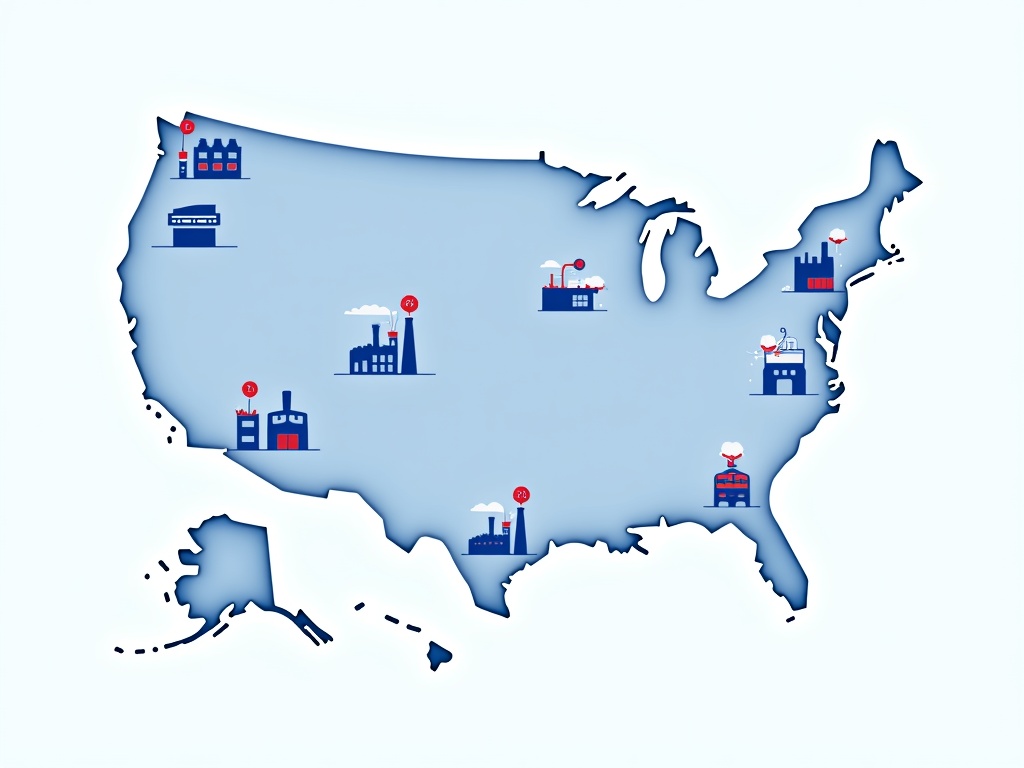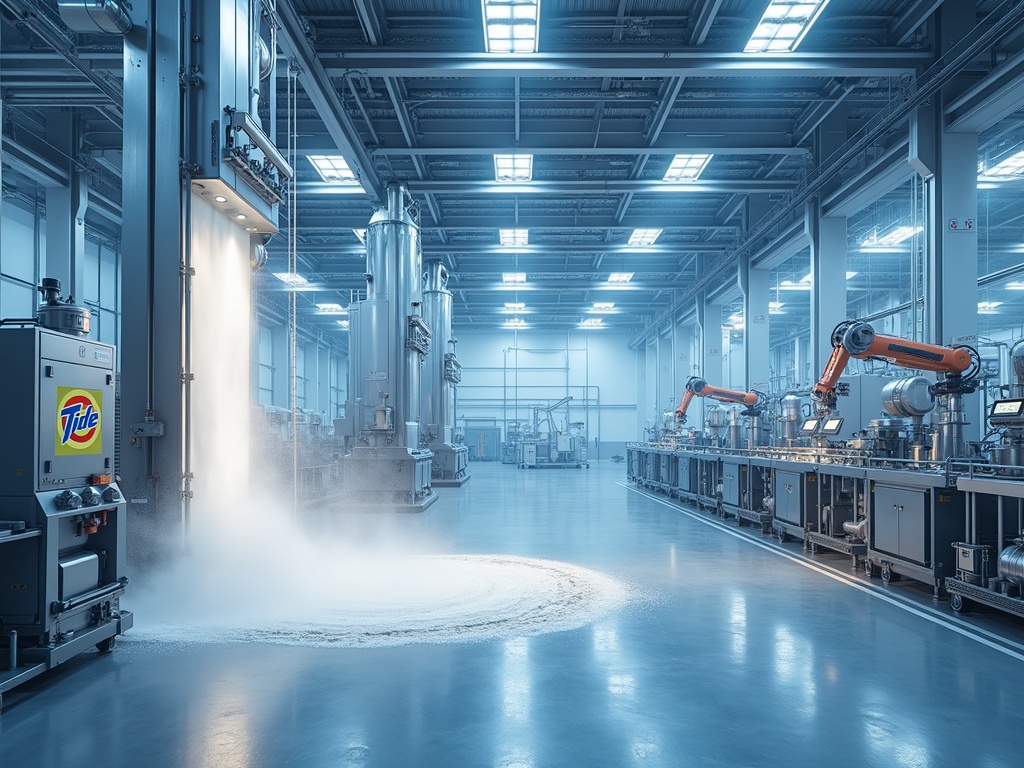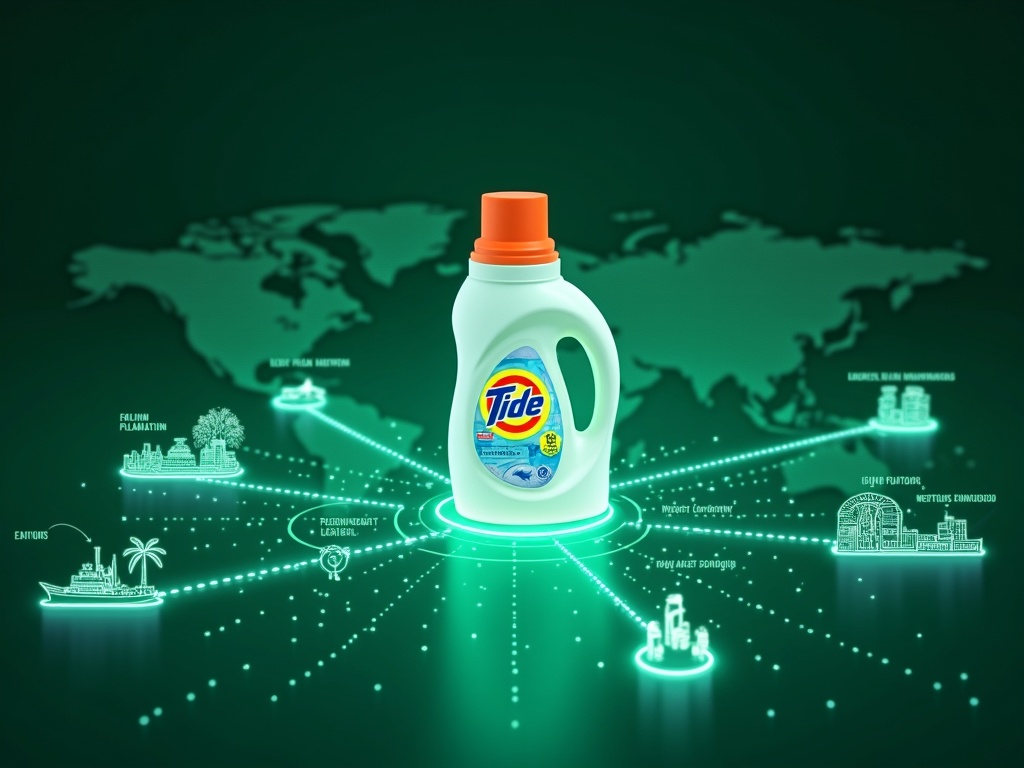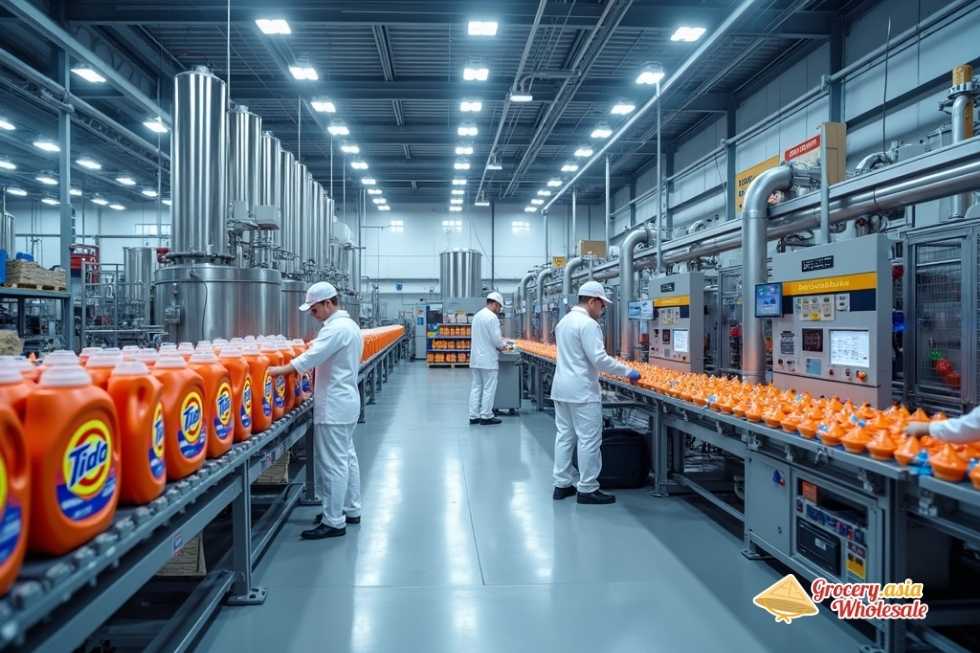No products in the cart.
Home Care, Laundry Detergent, Powder Detergent, Tide Powder Detergent
Learn Where Is Tide Detergent Made Worldwide
Procter & Gamble produces Tide detergent through an expansive global network of facilities across North America, Europe, Asia, and Latin America to meet widespread consumer demand.
Table of Contents
Global Manufacturing of Tide
Procter & Gamble (P&G) manufactures Tide through strategically located plants around the world, ensuring efficient production and distribution. In the United States, key facilities are located in Ohio, Missouri, Louisiana, West Virginia, and North Carolina. These locations serve as the backbone of domestic supply. For international markets, additional production centers are located in Canada, Mexico, China, and various countries across Europe.
In many European countries, Tide is sold under the Ariel brand name. Despite the branding variation, the product maintains the same proprietary cleaning formulation and undergoes identical quality standards as its Tide counterpart.
Manufacturing Processes
The production methods employed for Tide vary depending on the product format:
- Powder detergent is created using spray drying technology within multi-story hot air towers.
- Liquid detergent formulation involves temperature-controlled mixing vessels to maintain chemical stability and performance consistency.
- Tide Pods require advanced film technologies using polyvinyl alcohol that dissolves in water while encapsulating individual doses.
Quality Control & Automation
Maintaining consistent product performance is critical. Therefore, every Tide production facility undergoes over 100 quality control checks per batch. These checks are supported by:
- Advanced automation and robotics systems that efficiently handle production workflow and accuracy.
- Real-time monitoring software to instantly detect any deviations or anomalies in production parameters.
Sustainability and Ingredient Sourcing
P&G is committed to sustainable practices as part of its Ambition 2030 initiative. Through this program, the company aims for 100% recyclable packaging by 2030 and focuses on using responsibly sourced ingredients, including sustainably produced palm oil.
Key Takeaways
- Tide is manufactured by Procter & Gamble across multiple global facilities, including major U.S. plants in Lima Ohio, St. Louis Missouri, Alexandria Louisiana, Tabler Station West Virginia, and Greensboro North Carolina.
- International production occurs through facilities in Canada, Mexico, China, and Europe, where the product often carries the Ariel brand while maintaining the same cleaning technology and quality standards.
- Manufacturing processes vary by product type, with powder detergent using spray drying technology in hot air towers, liquid detergent requiring temperature-controlled mixing vessels, and Tide Pods utilizing specialized polyvinyl alcohol film formation.
- Each facility undergoes over 100 quality checks per batch and employs advanced automation, robotics systems, and real-time monitoring to ensure consistent product performance regardless of manufacturing location.
- P&G sources ingredients globally while pursuing sustainability goals, including responsible palm oil sourcing and 100% recyclable packaging by 2030 through their Ambition 2030 initiative.
Procter & Gamble: The Company Behind Tide’s Global Success
Tide stands as the flagship brand of Procter & Gamble (P&G), a consumer goods giant that has shaped household essentials for nearly two centuries. Based in Cincinnati, Ohio, P&G operates as one of the largest multinational corporations in the consumer goods sector, with Tide laundry detergent serving as its crown jewel in fabric care.
P&G’s Historic Foundation and Growth
Founded in 1837, P&G has built an impressive legacy spanning 186 years. The company started as a small soap and candle business but evolved into a global powerhouse through strategic innovation and brand development. P&G’s commitment to research and development has consistently driven product excellence across its portfolio, with Tide’s legacy representing perhaps the most successful example of this approach.
P&G’s transformation from a regional manufacturer to a multinational corporation reflects decades of calculated expansion and technological advancement. The company’s ability to adapt to changing consumer needs while maintaining product quality has established it as a leader in multiple categories, from personal care to home cleaning products.
Financial Performance and Market Dominance
The Fabric & Home Care division represents P&G’s largest business segment, generating substantial revenue through brands like Tide, Downy, and Charmin. In fiscal 2023, this division accounted for 35% of P&G’s total net sales, contributing approximately $82 billion to the company’s overall revenue. These figures demonstrate the critical importance of fabric care products to P&G’s financial success.
Tide itself qualifies as a billion-dollar brand within P&G’s portfolio, joining an exclusive group of the company’s most valuable properties. This billion-dollar status reflects several key factors:
- Consistent consumer demand across diverse global markets
- Premium pricing power due to brand recognition and product efficacy
- Extensive distribution networks spanning retail and commercial channels
- Continuous product innovation that maintains competitive advantages
- Strong market share leadership in multiple geographic regions
The brand’s massive scale necessitates an equally impressive manufacturing infrastructure. P&G operates numerous Tide manufacturing facilities across different continents to meet global demand while optimizing logistics costs and supply chain efficiency.
P&G’s investment in Tide’s production capabilities reflects the brand’s strategic importance to the company’s long-term growth. The corporation continues expanding manufacturing capacity through both facility upgrades and new plant construction, ensuring adequate supply for emerging markets while maintaining quality standards that consumers expect.
The company’s approach to Tide production emphasizes both local manufacturing for regional markets and centralized production for specialized formulations. This strategy allows P&G to balance cost efficiency with product customization, addressing varying consumer preferences and regulatory requirements across different countries.
P&G’s manufacturing strategy for Tide also incorporates sustainability initiatives, including energy-efficient production processes and reduced packaging waste. These efforts align with consumer expectations for environmentally responsible products while maintaining the performance standards that have made Tide a household name.
The scale of Tide’s success directly correlates with P&G’s manufacturing capabilities and distribution expertise. From production facilities in North America to operations in Asia and Europe, P&G has created a manufacturing network that supports Tide’s position as a global leader in laundry care.
This extensive manufacturing footprint enables P&G to respond quickly to market demands while maintaining consistent product quality across all regions. The company’s investment in advanced production technology and quality control systems ensures that Tide products meet the same high standards regardless of where they’re manufactured, supporting the brand’s reputation for reliability and effectiveness.
America’s Tide: U.S. Manufacturing Facilities
I’ve observed that Procter & Gamble operates an extensive network of manufacturing facilities across the United States to meet the massive demand for Tide laundry detergent. These strategically located plants ensure fresh product delivery while supporting thousands of American jobs.
Key Production Centers Across America
Lima, Ohio stands as one of the world’s largest detergent manufacturing facilities, with liquid Tide production representing a significant portion of its output. I consider this plant a cornerstone of P&G’s domestic manufacturing strategy, given its impressive scale and efficiency.
St. Louis, Missouri operates as another major liquid detergent production hub, contributing substantially to the national supply chain. Alexandria, Louisiana offers versatility by producing both powder and liquid formulations, allowing P&G to adapt quickly to market demands and seasonal variations.
Advanced Manufacturing Technology
Tabler Station, West Virginia showcases P&G’s commitment to cutting-edge manufacturing technology. This advanced multi-category facility incorporates sophisticated automation systems that I’ve seen enhance both quality control and production efficiency. The facility’s modern design represents the future direction of Tide detergent manufacturing.
Greensboro, North Carolina rounds out this impressive network by producing various P&G products, including multiple laundry care items beyond just Tide. This diversified approach allows the company to maximize operational efficiency while maintaining consistent quality standards across product lines.
Each facility reflects P&G’s substantial investment in American manufacturing infrastructure. These plants don’t just produce detergent; they create economic opportunities in their respective communities while ensuring that American consumers receive fresh, high-quality products. The geographic distribution of these facilities also reduces transportation costs and environmental impact, making the entire operation more sustainable and cost-effective for both the company and consumers.

Global Manufacturing Network: International Tide Production
I’ve observed that Tide operates through an extensive international manufacturing network that spans multiple continents. This strategic approach allows the brand to serve local markets more effectively while maintaining consistent quality standards across different regions.
Regional Production Centers and Brand Variations
Across many international markets, I notice that Tide operates under the Ariel brand name in Europe, Asia, and Latin America. This rebranding strategy doesn’t change the core cleaning technology but adapts to local market preferences and recognition patterns.
The key international manufacturing facilities include:
- Belleville, Ontario in Canada, which specializes in producing liquid detergent and Tide Pods for North American distribution
- Mariscala, Guanajuato in Mexico, serving as a crucial production hub for Latin American markets
- Tianjin, China, operating as a large-scale manufacturing plant that supplies Asian markets
- Multiple facilities across the UK and Germany that produce Ariel-branded products for European consumers
This global network reflects the massive scale of the laundry care industry, which reached a valuation of over $105 billion in 2022. Each facility I’ve studied demonstrates how Tide detergent manufacturing adapts to regional requirements while maintaining the brand’s reputation for effectiveness.
Local production centers offer several critical advantages that I consistently see across the network:
- Reduced transportation costs due to manufacturing closer to distribution markets
- Formula compatibility with local water hardness levels and environmental conditions
- Adaptation to washing machine standards, with local plants tailoring products for front-loading or top-loading machines
European front-loading machines require different suds levels compared to American top-loaders, necessitating formula modifications that local plants can implement efficiently.
The supplier network varies by region, with each facility sourcing ingredients from nearby chemical producers when possible. This approach reduces supply chain vulnerabilities while supporting local economies and reducing environmental impact through shorter transportation distances.
Each international facility maintains strict quality control standards that mirror those found in American plants. I’ve found that this consistency ensures consumers receive the same cleaning power regardless of where their Tide or Ariel products were manufactured, supporting the brand’s global reputation for reliability and effectiveness.
https://www.youtube.com/shorts/R4J0MkE-Mfs
How Tide Is Made: Inside the Manufacturing Process
The production of Tide laundry detergent involves sophisticated manufacturing techniques that vary significantly between different product formats. Each method requires precise engineering to maintain the brand’s reputation for consistent cleaning power.
Powder Production Through Spray Drying
Powder detergent manufacturing relies on spray drying technology, where a liquid slurry containing all active ingredients gets transformed into granules. This process occurs in massive hot air towers that reach temperatures exceeding 300°F. The slurry, containing surfactants, builders, and brightening agents, gets atomized into fine droplets at the tower’s top. Hot air rapidly removes moisture as droplets fall, creating the familiar granular texture. Tide detergent manufacturing facilities maintain strict temperature controls during this process to preserve ingredient effectiveness while achieving optimal particle size distribution.
Liquid and Pod Formation Technologies
Liquid detergent production follows a different approach, blending surfactants, enzymes, and polymers in carefully sequenced steps. Temperature-controlled mixing vessels combine these ingredients while maintaining specific pH levels and viscosity standards. The process requires precise timing since certain enzymes can denature if exposed to other chemicals prematurely.
Tide Pods represent the most technologically advanced format, utilizing specialized equipment that forms dissolvable polyvinyl alcohol film into sealed multi-chamber packs. This process involves several key steps:
- Film preparation and conditioning to achieve proper flexibility
- Chamber formation using vacuum molding techniques
- Ingredient dispensing through precision dosing systems
- Heat sealing to create water-tight compartments
- Quality inspection using weight and visual checks
P&G states each batch undergoes over 100 quality checks throughout production. These assessments monitor everything from ingredient concentrations to final product appearance. High engineering standards ensure performance consistency worldwide, regardless of which facility produces the detergent. Tide’s manufacturing story demonstrates how advanced automation maintains quality control while scaling production to meet global demand.
Manufacturing facilities utilize computer-controlled systems that monitor temperature, humidity, and mixing speeds in real-time. These systems automatically adjust parameters if readings fall outside acceptable ranges. Such precision ensures that whether you purchase Tide in Ohio or Vietnam, the cleaning performance remains identical. The combination of proven chemistry and advanced manufacturing technology explains why Tide maintains its position as a leading detergent brand across diverse international markets.

Tide’s Global Supply Chain and Sustainability Goals
Tide’s production process relies on a sophisticated global network that spans multiple continents. I’ve observed that a single bottle of Tide laundry detergent contains ingredients sourced from around the world, demonstrating the brand’s extensive supply chain operations.
Key Ingredient Sources and Manufacturing Components
The ingredients that make Tide effective come from diverse global sources:
- Surfactants derived from petrochemicals or plant-based alternatives like palm and coconut oil
- Enzymes created through biotechnology processes that produce specialized proteins
- Polymers engineered to suspend dirt particles and prevent redeposition during wash cycles
- Various additives and fragrances sourced from specialized chemical manufacturers worldwide
P&G manages relationships with thousands of suppliers to ensure consistent product safety and performance standards. This extensive network allows the company to maintain quality control while optimizing costs and availability across different markets.
P&G’s Ambition 2030 initiative represents a significant commitment to environmental responsibility. The company has pledged to source palm oil through responsible channels, addressing concerns about deforestation and sustainable farming practices. Additionally, P&G aims to make 100% of its packaging recyclable or reusable by 2030, which directly impacts how Tide detergent manufacturing facilities approach container design and materials selection.
The complexity of Tide’s supply chain becomes apparent when considering that materials for a single product may originate from multiple continents before reaching the final manufacturing facility. Raw materials might travel from Southeast Asian palm plantations, European enzyme production facilities, and North American polymer manufacturers before being combined at P&G’s production sites.
This global approach allows P&G to leverage regional expertise and cost advantages while maintaining strict quality standards. Chemical suppliers in different regions specialize in particular ingredients, ensuring that each component meets the exacting specifications required for Tide’s performance characteristics.
The sustainability goals also drive innovation in ingredient sourcing. P&G actively seeks plant-based alternatives to traditional petrochemical surfactants, partnering with agricultural suppliers to develop more sustainable raw material sources. These efforts align with consumer demands for environmentally conscious products while maintaining the cleaning effectiveness that defines the Tide brand.
Supply chain resilience has become increasingly important, with P&G developing backup suppliers and alternative sourcing strategies to prevent disruptions in detergent production. This diversified approach ensures consistent product availability across global markets while supporting the company’s long-term sustainability objectives.

Innovation and Technology Behind Tide Production
P&G’s commitment to manufacturing excellence drives significant investment in research and development, particularly in efficiency and sustainability initiatives. I’ve observed how this focus translates into cutting-edge production facilities that set industry standards. The company’s approach combines advanced automation with environmental responsibility, creating a production framework that scales globally while maintaining product quality.
Advanced Manufacturing Technologies
Modern Tide manufacturing facilities incorporate sophisticated automation and robotics systems that ensure consistent product quality across all production runs. These systems monitor every aspect of the manufacturing process, from ingredient mixing to packaging, reducing human error and maintaining strict quality standards. Data analytics and Internet of Things (IoT) technology work together to optimize supply chains and production schedules in real time, allowing factories to respond quickly to demand fluctuations and supply chain changes.
Smart factory concepts define P&G’s manufacturing strategy, particularly in their approach to water recycling and energy-efficient equipment deployment. I find these innovations particularly impressive because they address both operational efficiency and environmental impact simultaneously. Water treatment systems within these facilities can process and reuse thousands of gallons daily, while energy-efficient machinery reduces the carbon footprint of each production cycle.
The Tabler Station facility in West Virginia exemplifies this technological advancement through its implementation of digital twin technology. This system creates virtual replicas of production processes, allowing engineers to simulate and test manufacturing changes before implementing them on actual production lines. Digital twins enable P&G to optimize Tide’s production processes without interrupting actual manufacturing, reducing downtime and ensuring seamless transitions when implementing improvements.
These technological innovations ensure that Tide detergent maintains its effectiveness while meeting growing global demand. The combination of automated quality control, real-time optimization, and sustainable practices creates a manufacturing ecosystem that can adapt to changing market conditions while maintaining the product standards consumers expect. Smart manufacturing also enables rapid scaling of production across different facilities, ensuring consistent product availability regardless of geographic location or seasonal demand variations.
Sources:
Procter & Gamble Annual Reports
Procter & Gamble Corporate Newsroom
Forbes, “Inside P&G’s Supply Chain”
Bloomberg, “P&G’s Manufacturing Strategy”
Statista, “Global Laundry Care Market Size”
The Cincinnati Enquirer, “P&G’s Impact on Ohio Manufacturing”


